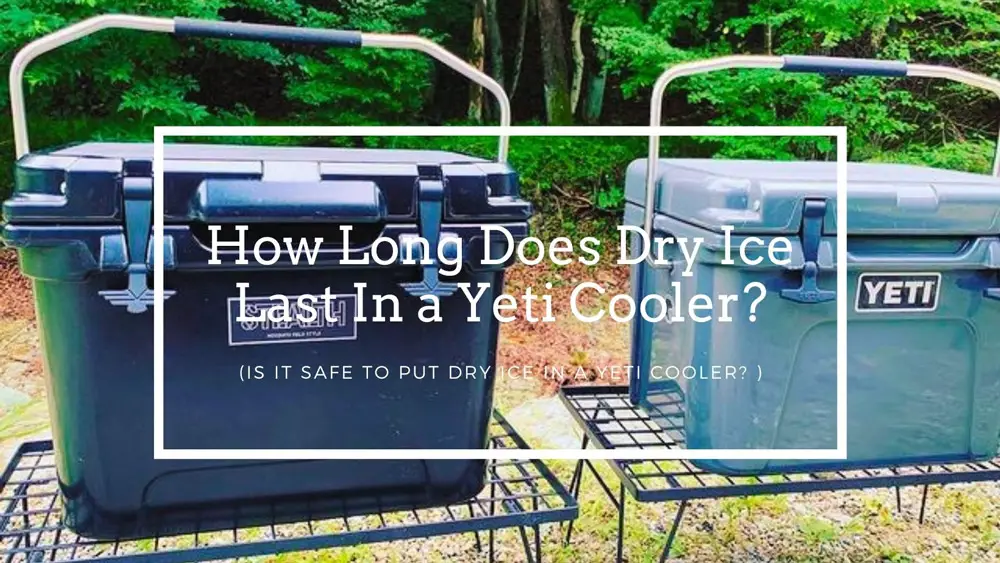Do you find foods and drinks turning bad, despite using an outdoor fridge when you’re on the road for several days?
Rather than using regular ice, you might want to store them in dry ice to keep them safe longer. However, you will need to buy an appropriate cooler for the best results.
Luckily, Yeti coolers are perfect for storing dry ice but are they worth the investment? You might be wondering – how long does dry ice last in a Yeti?
So, let’s find out.
How Long Does Dry Ice Last In A Yeti?
Compared to other coolers available on the market, dry ice lasts longer in a Yeti. Thanks to its roto-mold construction and THERMA-FIT technology, it keeps the ice safe for an average of 5 days.
Dry ice will last from 2-7 days in a bigger Yeti cooler, depending upon the size of the cooler and the quantity of dry ice that you want to store. For instance, you might need around 15 pounds of dry ice to transport food and other perishables over long distances. Usually, larger models can hold more than double the weight of ice, making them ideal for warm climates.
We suggest that you measure the length of the cooler and pack it with 10-pound ice blocks every 15 inches. This should keep the ice safe and the eatables fresh for at least 48 hours.
Can You Put Dry Ice In A Every Yeti Cooler? Is It Safe?
The primary concern among consumers is that dry ice releases gases that expand and increase the pressure inside the container. In some cases, not using an adequate cooler may cause it to explode.
Hence, the engineers have added reinforcements, thereby enabling the Yeti coolers to withstand excess pressure. We also found that most models aren’t airtight and allow the gas to escape to control the pressure build-up.
Long story short, you can only put dry ice in certain Yeti’s product lines, including the YETI Ice Buckets, Tundra, and Roadie Hard Coolers; While you can’t put dry ice in YETI V-Series and Hopper soft coolers.
Can I Put Dry Ice In Yeti Hopper?
The Yeti Hopper is a type of soft cooler, and it’s therefore risky to put dry ice in it. You might end up damaging the unit because it has a soft inner lining that can’t handle extremely cold temperatures.
Moreover, compared to regular ice, dry ice turns into a gas and helps keep frozen foods safe for longer periods. On the flip side, the gas build-up inside the chamber leads to an increase in pressure which could cause the cooler to explode.
Also, most soft coolers have a thin plastic lining which might change shape and turn brittle due to the extreme temperatures, thereby causing it to break easily.
Overall, dry ice has a temperature of -109 degrees Fahrenheit, while regular ice reaches a maximum of 32 degrees Fahrenheit. So, it’s safe to say that it would be best to use the Yeti Hopper for storing normal ice.
Will Dry Ice Make My Yeti Explode?
The impact of dry ice on a Yeti cooler depends upon the model you’re using. By now, you may have realized that hard Yeti coolers are more suitable for storing dry ice, so there’s no chance of them exploding.
In fact, people have used them in harsh climates with success and to transport food over long distances. Additionally, the container isn’t 100% airtight, thereby ensuring that the gas can escape through minute gaps in the cooler to keep the pressure under control.
How To Use Dry Ice In A Yeti Cooler?
It’s easy to use dry ice in a yeti cooler, but you must ensure that you don’t overfill the container. We must also remind you to wear gloves to prevent skin burns while handling the ice slabs.
All you need to do is fill the cooler with an appropriate amount of dry ice, and place it in a well ventilated area. Thanks to its insulated polyethylene walls, you will find that the right model maintains cooler temperatures and can store food and drink for several days.
What’s more, make sure you plug all gaps with dry ice to pack the food items tightly. Then, apply foam insulation before securely attaching the door to ensure that the contents remain safe.
Final Thoughts
Do you have all the information about dry ice and Yeti coolers to make an informed decision?
Before signing off, we’ll leave you with this tip: think about why you need a Yeti cooler and how frequently you’ll have to use it. This will help you purchase the appropriate model that meets your demands.
Along with that, it would be best to use safety equipment like gloves and goggles while handling the ice slabs to stay safe. On that note, it’s now time for us to say goodbye.
Rest assured, with the right Yeti cooler, you can enjoy a great outdoor expedition with your family.


